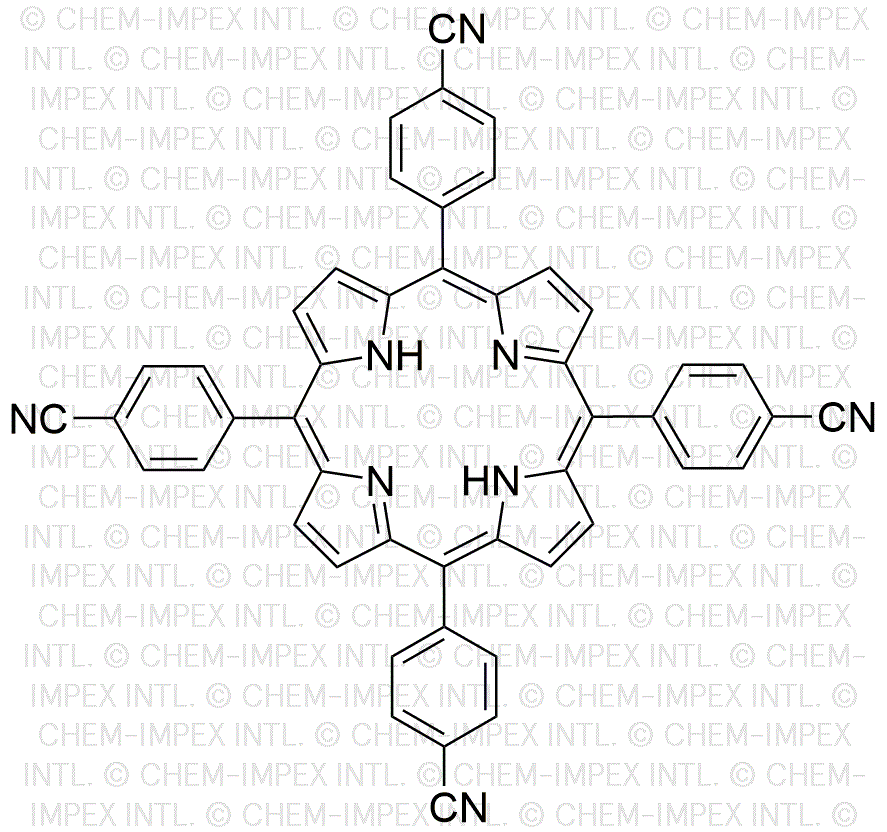5,10,15,20-(Tetra-4-cyanophenyl)porphyrin is widely utilized in research focused on:
- Photodynamic Therapy: This compound is effective in targeting cancer cells through light-activated processes, making it a promising agent in cancer treatment.
- Solar Energy Conversion: Its unique structure allows for efficient light absorption, which can enhance the performance of solar cells by converting sunlight into electricity.
- Fluorescent Probes: The compound serves as a fluorescent marker in biological imaging, aiding researchers in visualizing cellular processes with high precision.
- Electrochemical Sensors: It can be employed in the development of sensors for detecting environmental pollutants, providing a reliable method for monitoring air and water quality.
- Organic Light Emitting Diodes (OLEDs): This chemical is used in the fabrication of OLEDs, contributing to the advancement of display technologies with improved efficiency and color vibrancy.
General Information
Properties
Safety and Regulations
Applications
5,10,15,20-(Tetra-4-cyanophenyl)porphyrin is widely utilized in research focused on:
- Photodynamic Therapy: This compound is effective in targeting cancer cells through light-activated processes, making it a promising agent in cancer treatment.
- Solar Energy Conversion: Its unique structure allows for efficient light absorption, which can enhance the performance of solar cells by converting sunlight into electricity.
- Fluorescent Probes: The compound serves as a fluorescent marker in biological imaging, aiding researchers in visualizing cellular processes with high precision.
- Electrochemical Sensors: It can be employed in the development of sensors for detecting environmental pollutants, providing a reliable method for monitoring air and water quality.
- Organic Light Emitting Diodes (OLEDs): This chemical is used in the fabrication of OLEDs, contributing to the advancement of display technologies with improved efficiency and color vibrancy.
Documents
Safety Data Sheets (SDS)
The SDS provides comprehensive safety information on handling, storage, and disposal of the product.
Product Specification (PS)
The PS provides a comprehensive breakdown of the product’s properties, including chemical composition, physical state, purity, and storage requirements. It also details acceptable quality ranges and the product's intended applications.
Certificates of Analysis (COA)
Search for Certificates of Analysis (COA) by entering the products Lot Number. Lot and Batch Numbers can be found on a product’s label following the words ‘Lot’ or ‘Batch’.
Numéro de catalogue
Numéro de lot/série
Certificates Of Origin (COO)
This COO confirms the country where the product was manufactured, and also details the materials and components used in it and whether it is derived from natural, synthetic, or other specific sources. This certificate may be required for customs, trade, and regulatory compliance.
Numéro de catalogue
Numéro de lot/série
Safety Data Sheets (SDS)
The SDS provides comprehensive safety information on handling, storage, and disposal of the product.
DownloadProduct Specification (PS)
The PS provides a comprehensive breakdown of the product’s properties, including chemical composition, physical state, purity, and storage requirements. It also details acceptable quality ranges and the product's intended applications.
DownloadCertificates of Analysis (COA)
Search for Certificates of Analysis (COA) by entering the products Lot Number. Lot and Batch Numbers can be found on a product’s label following the words ‘Lot’ or ‘Batch’.
Numéro de catalogue
Numéro de lot/série
Certificates Of Origin (COO)
This COO confirms the country where the product was manufactured, and also details the materials and components used in it and whether it is derived from natural, synthetic, or other specific sources. This certificate may be required for customs, trade, and regulatory compliance.


